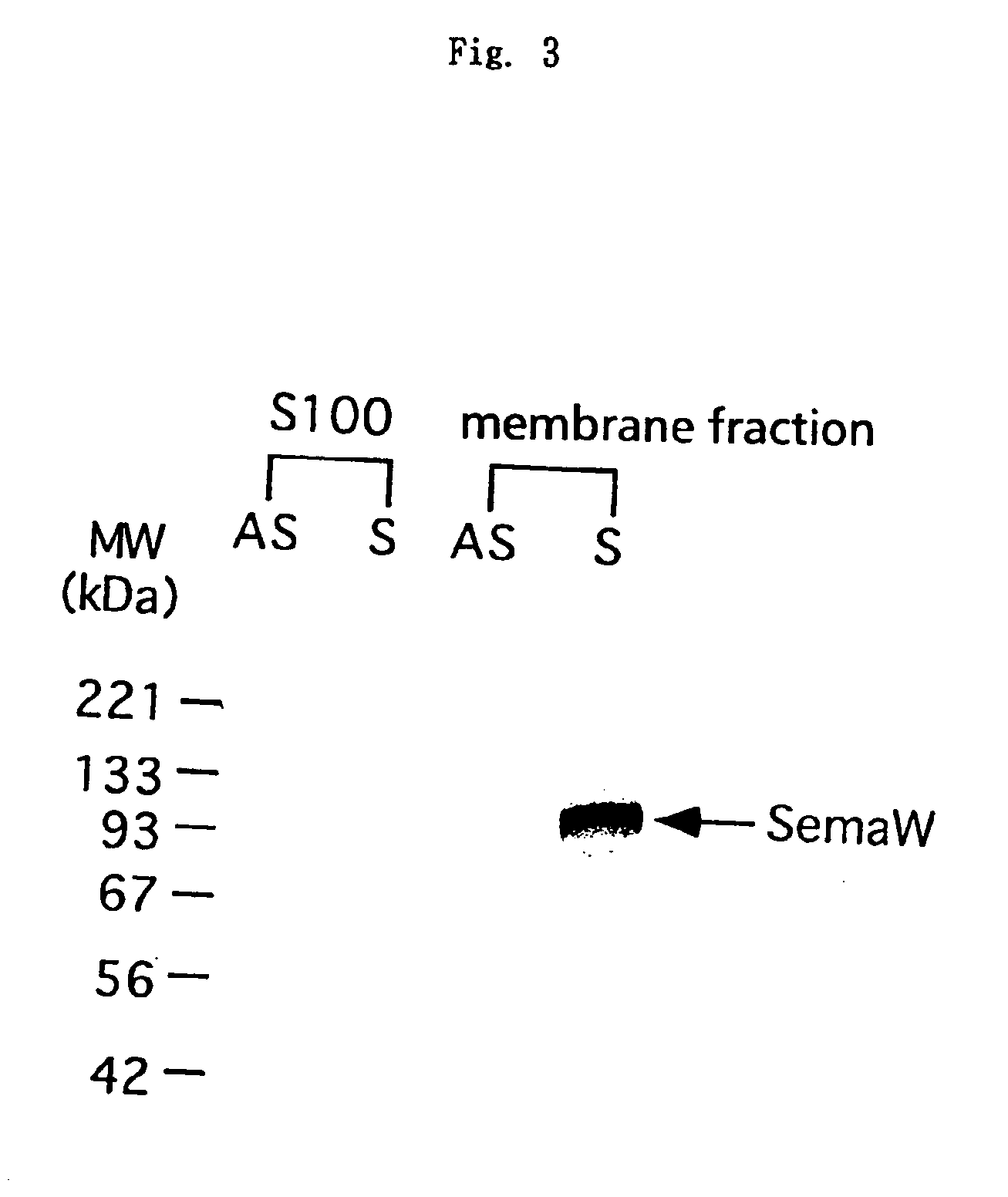Semaphorin gene: Semaphorin W
a technology of semaphorin and semaphorin, applied in the field of semaphorin w, can solve the problems of low stability and specificity, inability to regenerate the central nervous system (cns)-neuron in higher organisms such as humans, and inability to regenerate. effect, so partial and incompl
- Summary
- Abstract
- Description
- Claims
- Application Information
AI Technical Summary
Benefits of technology
Problems solved by technology
Method used
Image
Examples
example 1
Search Through Database for a Novel Semaphorin Gene
[0146]Using the dbEST database of the National Center for Biotechnology Research (Bethesda, Md., USA), DNA sequence which encodes an amino acid sequence well conserved in known Semaphorin genes was searched. As a result, T09073 proved to encode as a partial sequence, the sequence: Gln-Asp-Pro-Val-Cys-Ala-Trp (SEQ ID NO. 12) which is similar to the sequence consisting of seven amino acids extremely well conserved among known Semaphorin genes: Gln (or Arg)-Asp-Pro-Tyr-Cys-Ala (or Gly)-Trp (SEQ ID NO. 13). It was, however, impossible to conclude that the sequence is part of a novel Semaphorin gene, partly because this sequence consisting of 364 bp is so short and partly because the reading frame could not be determined due to the presence of undetermined bases. In addition, distribution of a gene containing this sequence was not known. Thus, the present inventors adopted the following strategy. Firstly, we confirmed by determining dist...
example 2
Distribution of Expression of Gene Containing T09073
[0147]Distribution of expression of a gene containing T09073 as a partial sequence was studied by Northern method. Although T09073 is presumed to be a human gene sequence since it has been submitted to the database as a sequence derived from a human child brain cDNA library, Northern analysis was carried out with rat samples in the light of the ease of the sample preparation. RNAs were prepared from various tissues of adult and fetal rats according to AGPC method (Takashi Tuji and Toshikazu Nakamura, Jikken-Igaku, vol. 9, 1991, pp. 1937-1940; M. F. Ausubel et al., ed., “Current Protocols in Molecular Biology”, 1989, pp. 4.2.4-4.2.8, Greene Pub. Associates & Wiley-Interscience). Briefly, 10 ml of a denaturing solution (4M guanidine thiocyanate, 25 mM sodium citrate (pH 7.0), 0.5% sarkosyl, 0.1 M 2-mercaptoethanol) was added to each 1 g of excised tissues, and quickly homogenized using a Polytron homogenizer. To the homogenate, 0.1 v...
example 3
Cloning of Rat Semaphorin W Gene
[0149]In order to determine whether or not the above gene containing T09073 sequence actually corresponds to a novel Semaphorin gene, the inventors cloned the gene in full length using the 196 bp DNA fragment prepared in the above Example 2 as a probe, and determined the sequence. Because of the ease of sample preparation, the rat gene was firstly cloned. cDNA libraries were prepared by a conventional method described in the above-mentioned laboratory manual, using mRNAs prepared from rat brain and muscle by conventional procedures with Lambda Zap II (λZapII) cDNA Library Preparation Kit (Stratagene). About 150 thousand plaques were then generated on agarose plates using the cDNA library, and the plaques were transferred onto nylon membranes (Nippon Pall). After denaturing and neutralizing the DNAs, they were fixed with ultraviolet rays of 0.6 J / cm2, and used in hybridization. The hybridization was carried out by placing the nylon membrane and the 196...
PUM
| Property | Measurement | Unit |
|---|---|---|
| temperature | aaaaa | aaaaa |
| weight | aaaaa | aaaaa |
| pH | aaaaa | aaaaa |
Abstract
Description
Claims
Application Information
 Login to View More
Login to View More - R&D
- Intellectual Property
- Life Sciences
- Materials
- Tech Scout
- Unparalleled Data Quality
- Higher Quality Content
- 60% Fewer Hallucinations
Browse by: Latest US Patents, China's latest patents, Technical Efficacy Thesaurus, Application Domain, Technology Topic, Popular Technical Reports.
© 2025 PatSnap. All rights reserved.Legal|Privacy policy|Modern Slavery Act Transparency Statement|Sitemap|About US| Contact US: help@patsnap.com



